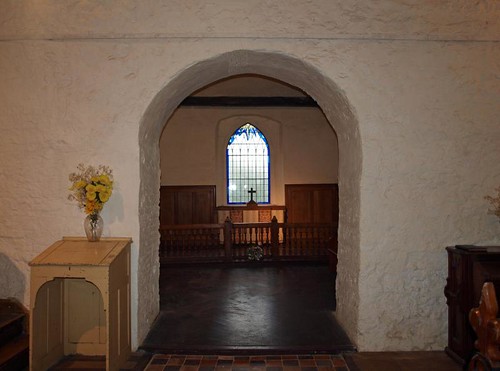ALL SAINTS. A small church, on its own, on the escarpment of the Thames. Nave and chancel and small bell-turret. In the nave S wall remains of a Norman window. The church was restored in 1837, by T. Sneezum. He must be responsible for the E and W windows and probably also the W gallery on cast-iron columns. FONT. Square bowl on five supports. One side of the bowl is decorated with a zig-zag motif. C12-C13. - PULPIT with READER’S PEW below. - COMMUNION RAIL, partly C17.
VANGE. Here the Langdon Hills come down to the drained marshes of the Thames estuary, through which flows Vange Creek. The Thames is now away from the village, but for hundreds of years man fought a losing battle with the floods, landowners having to repair the embankment walls or forfeit their lands. So sadly beaten were they that in 1620 the Government sent for expert Dutchmen to set up stout walls, and gave them these forfeited lands as their fee.
So it was that Cornelius Vandenanker came here with hundreds of his countrymen, reclaiming the marshes from Dagenham to Canvey by transporting tons of chalk from the quarries at Grays, and in some places constructing three walls, one within the other. He amassed a great fortune by selling the marshes he had redeemed. There is a record that his wife was buried in Downham church in 1692.
Vange is now a fast-growing place, for though the Thames is away Thameshaven is spreading in. Its small church is solitary on a hillock projecting toward the Thames. No road approaches, a few elms shading the long path across the fields which brings us to the churchyard. The church, less than 60 feet long, is crowned with a tiny wooden turret perched on the nave. The manor was held for Bishop Odo, the Conqueror’s stepbrother, and the church was apparently begun about his time if we judge by its solid chancel arch. There is a blocked Norman window and a Norman font, its solid square bowl with rough zigzag lines on one face and foliage on the top.
So it was that Cornelius Vandenanker came here with hundreds of his countrymen, reclaiming the marshes from Dagenham to Canvey by transporting tons of chalk from the quarries at Grays, and in some places constructing three walls, one within the other. He amassed a great fortune by selling the marshes he had redeemed. There is a record that his wife was buried in Downham church in 1692.
Vange is now a fast-growing place, for though the Thames is away Thameshaven is spreading in. Its small church is solitary on a hillock projecting toward the Thames. No road approaches, a few elms shading the long path across the fields which brings us to the churchyard. The church, less than 60 feet long, is crowned with a tiny wooden turret perched on the nave. The manor was held for Bishop Odo, the Conqueror’s stepbrother, and the church was apparently begun about his time if we judge by its solid chancel arch. There is a blocked Norman window and a Norman font, its solid square bowl with rough zigzag lines on one face and foliage on the top.



Beautifully written. I like your spare style, which suits the subject, I feel. Thank you.
ReplyDeleteThank you!
Delete